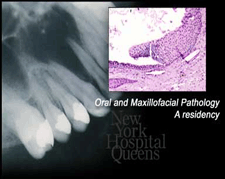المقالات
Exostosis

An exostosis is a slow-growing, tumor-like bony growth that is typically found on the outer surface of the upper gums, on the roof of the mouth (the palate), or on the inner surface of the lower gums. Exostoses can also occur at any other site involving the upper and/or lower jaw bones. They can vary greatly in size, are hard to the touch, and can be either broad and flat or knob-shaped. Exostoses can exist in clusters or as singular growths. Typically they are little more than an annoyance, causing no pain and requiring no treatment, unless they interfere with the placement of a denture. When the exostosis is large, it is subject to irritation and ulceration from repeated trauma. Once injured, they can be slow in healing because of the limited number of blood vessels on their thin tissue surface. Exotoses are more common in females, and normally do not develop in children. They occur most frequently in Native Americans and Eskimos. The tendency to develop these growths appears to be hereditary.
* To guard against infection that can result from persistent ulceration on the thin lining that covers the growth.
